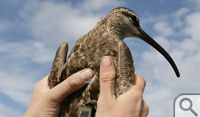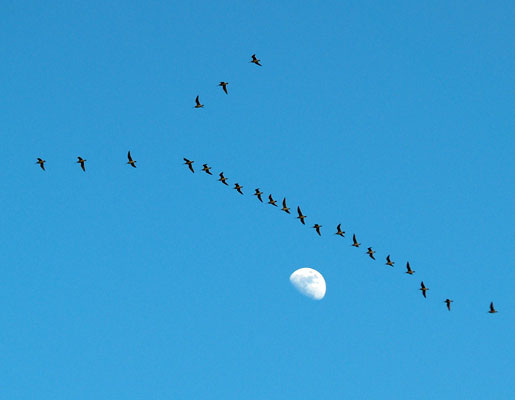Final Score: Whimbrels, 4—Hurricane Irene, 0
Hummingbirds hover and dart. Falcons swoop and dive. Cooper’s hawks are capable of jaw-dropping aerobatics.
Add the
homely whimbrel to this list of extreme fliers. Whimbrels are famed for their
ability to go the distance, routinely taking on nonstop migration flights of a
few thousand miles. Four of these long-billed shorebirds successfully made it
through Hurricane Irene, employing strategies ranging from sitting the storm
out to flying right into the teeth of the hurricane—and back out again.
The Center for Conservation Biology (CCB) is part of a consortium of ornithologists that has been fitting these extreme fliers with lightweight, solar-powered backpack transmitters to track their migrations between their high Arctic breeding grounds and wintering areas in South America and the Caribbean. Whimbrels often use the tidal creeks and marshes of Virginia’s Eastern Shore as staging areas on both northbound and southbound migrations.
In 2008, the CCB was able to track the 146-hour flight of a whimbrel named Winnie from the Eastern Shore to her breeding grounds on the Mackenzie River near the Alaska-Canada border. At some 3,200 miles, with an average air speed of 22 miles per hour, it was a record-setting flight for whimbrel distance. The next year, a whimbrel named Hope surprised scientists by logging a 5,600-mile odyssey in which she visited both of the well-known whimbrel breeding grounds, then not breeding.
Migrating whimbrels routinely put themselves in harm’s way. Bryan Watts, director of the Center for Conservation Biology, says that the southbound migration of the birds occurs during hurricane season and their routes usually take them over open ocean.
All four of the whimbrels being active tracked came up against Hurricane Irene and all came out with scarcely a ruffled feather. One, a bird named Chinquapin, flew unscathed through the most violent part of the hurricane. A second bird, Goshen, also tangled with Irene, but only had to deal with the outer bands of the storm. The remaining two, Hope and Machi, employed a different strategy, hunkering down on Virginia’s Eastern Shore while Irene raged overhead, pelting down nearly a foot of rain.
CCB Research Biologist Fletcher Smith says he expected Hope and Machi to take shelter in wooded areas, but satellite signals showed them in the middle of a marsh where they likely rode out the storm, literally, on rafts of floating wrack.
Chinquapin didn’t make an Eastern Shore stopover this year. He opted for the direct flight, leaving upper Hudson Bay on Aug. 20.  He flew right into Irene’s northeast
quadrant on Aug. 24. Satellite signals seemed to indicate Chinquapin had indeed
flown through the storm.
He flew right into Irene’s northeast
quadrant on Aug. 24. Satellite signals seemed to indicate Chinquapin had indeed
flown through the storm.
To make sure, researchers gathered at the Center for Conservation Biology’s offices on the William & Mary campus on the afternoon of Aug. 27, waiting like expectant fathers for the next scheduled transmission of coordinates. It came through at 4:20 p.m.—showing that Chinquapin was alive and well on the Bahamian island of Eleuthera.
In early September, Hope and Machi were still on the Eastern Shore, while Goshen is on the island of Antigua. The researchers expect all four to continue their migration. Last year, Hope stayed on St. Croix, Chinquapin wintered in coastal Suriname and Goshen and Machi opted for Brazil.
The transcontinental journeys of whimbrels not only reveal new information about the life cycle of shorebirds, Watts said, but also underscore the environmental importance of the Delmarva Peninsula, which includes the state of Delaware as well as the eastern shores of Maryland and Virginia.
The Center for Conservation Biology is a joint program of the College of William & Mary and Virginia Commonwealth University.
Funding
sources and collaborators involved in the whimbrel satellite tracking project
include the Center for Conservation Biology, Georgia Department of Natural
Resources Non-game Division, The Nature Conservancy, The U.S. Fish and Wildlife
Service, the Virginia Coastal Zone Management Program and Manomet Center for
Conservation Sciences. 
















